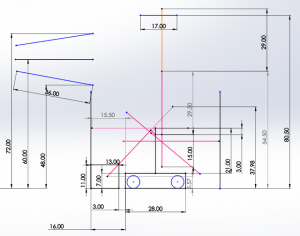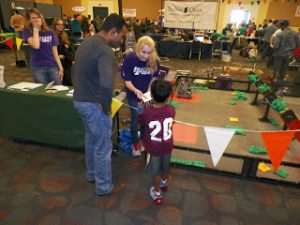We did more work on the 4-bar prototype today and got it lifting totes and containers. We will release videos in tomorrow’s post. We had to make slight modifications to the prototype to ensure that we are starting at an ideal distance from the floor and able to reach our desired height. We also worked on the passive manipulators and some programming. A few special projects began today, including a long-reach Recycle Container hook (tape measures are involved) and a bin-alignment device.
The following is a guide to being a good alliance partner. There are always various degrees of robot abilities in FRC games, but this year seems like it might have one of the most drastic ranges in recent years. Advanced teams are going to be very good, and struggling teams may find it difficult to score well and rank highly. We started talking about what we think the ideal third robot would do on an alliance at a regional (assuming that the first two robots are able to stack totes and at least one of them is able to stack recycling containers).
Ideal Partner Team Characteristics
- Controlled: There is a large risk of your own alliance members losing your hard-earned points if they don’t have good control over their robot. All members of an alliance should be able to drive their robots around a heavily congested field while keeping keen awareness of their surroundings. If you run into a bin too hard, you might knock down an adjacent stack. Programming and drive train design will help with this, but it will mostly be up to the driver and how much practice and focus he puts into his craft. This isn’t a year for aggressive drivers.
-
Drive train design suggestion: a slow, controllable drive train and a narrow chassis will make it easier to drive through congestion.
- Game Smart: Know the rules, and know how robots and teams work and behave. If you are at a later event, watch videos from prior events. Knowing where not to be during a match might be more important than knowing where to be. The top-scoring robots will have extremely efficient scoring mechanisms, and if any of their partners get in their way their alliance’s score will only go down. In a game like this year’s, your top scoring machine should have the right-of-way. Stay out of its way, and let it keep putting up points.
- Reliable: Any failures are catastrophic since every point counts during the 1st two rounds of the playoffs. Make sure your robot drives every match, you’re on time, you have spare parts or use common parts, etc.
- Nice People: This is on the list every year; if we’re going to be spending a few hours together, we should at least like talking with you. Be a nice team that is fun to be around.
Robot Abilities
- Noodling a recycling container: Although its true value is questionable since it is useless in eliminations, TNA is getting crippled soon. Be able to carry a recycling container to the feeder station so that a human player may noodle (or, to be politically correct, “deposit the litter” into) it. (Fun fact: most pool noodles are made from a material that many areas don’t recycle). Then, stash the bin somewhere for your partners. This could be an extremely quick way to add 18+ points to an alliance score. The RCs won’t be stacked till later in the match, anyway, for fear of having them fall off if placed too early. This leaves plenty of time for a third robot to be noodling.
- Tote assists from human player: Working with a human player to get stacks of 2 totes to your alliance partners is a valuable role. The shorter the distance they have to travel to stack totes, the better for your alliance. You may even be able to start the stacks for them by pushing or placing them on the scoring platform.
- Pulling totes from the landfill: This isn’t too valuable by itself since landfill totes aren’t already stacked and since they are located at the back of the playing field, where it will be harder for many teams to accurately acquire them because of their distance form the driver station. However, moving these totes may allow an alliance partner to remove the RCs from the step. These game pieces are going to be highly coveted, and the faster an alliance can get to them, the better, since it’s a race with the opposite alliance to obtain them. At many regionals, you won’t have alliance that can score 7 RCs, but a 4th container might make a difference for your alliance. If you can clear a path for your partners that need it, all the better for your team. BuildBlitz just posted a video of a simple tote dragging mechanism that may work very well for this.
- Acquire RCs from the step: This is a bit of a dream 3rd alliance partner, but if you can get the RCs from the step and you’re available in the 3rd round, teams will be counting their lucky stars and wondering why other teams always seem to draft poorly.
- Righting an RC: This is another dream ability, but it is one that teams doing the picking shouldn’t overlook in a partner.
- Autonomous: With top tier teams being able to independently form a container stack in auto, a third partner should at least have the ability to drive into the auto zone. It is nice for teams to have autonomous features, including:
- Being able to take a container to the auto zone
- Being able to drive over the platform to the auto zone
- Being able to delay any of its autonomous commands
- Being able to drag totes from the landfill and to the scoring platform
- DREAM: getting RCs from the step
“When you’re forced to be simple, you’re forced to face the real problem. When you can’t deliver ornament, you have to deliver substance.”
– Paul Graham



